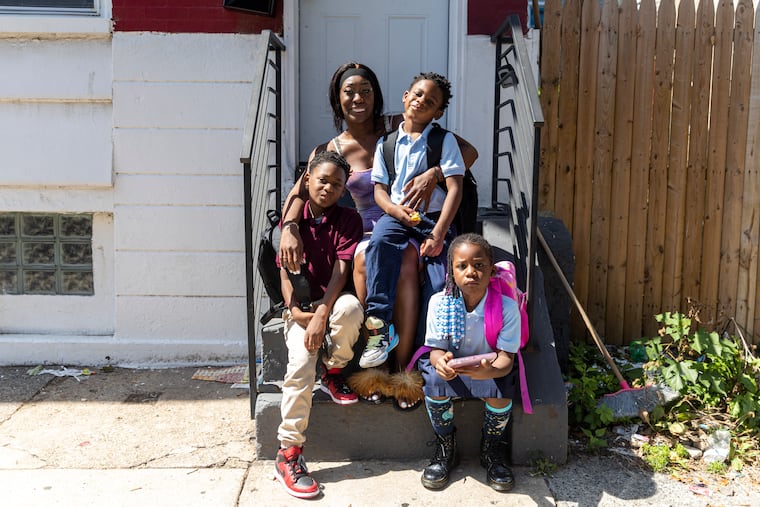A triple shooting happened outside this Philly elementary school. But for Kensington families, the risk of violence is constant.
“We don’t play in the parks, ever,” said Jasmine Albury, a mother of five. “There are shootings everywhere.”

Jasmine Albury doesn’t like to linger on Philadelphia’s streets. She and her five kids are an “in-and-out family,” she says — they leave the house only for the things they need.
“We don’t play in the parks, ever,” said Albury, who lives in North Philadelphia. “There are shootings everywhere.”
When three people last week were shot outside Willard Elementary — the Kensington school where her son is a fourth grader — Albury felt despair, she said, but certainly not shock. For many Philadelphia families, the city’s gun violence crisis means constant risk and trauma exposure in daily tasks as simple as getting children to and from school.
No part of the city is as plagued by gun violence as Kensington, largely fueled by an open-air drug market and higher rates of poverty. Law enforcement officials have said that dealers sell heroin, crack, and other drugs on more than 80 blocks in the neighborhood.
Willard is just one-quarter of a mile from the intersection of Kensington and Allegheny, the longtime hub of the area’s drug trade. A previous Inquirer analysis found that within a five-minute walk of this intersection, more than 300 people have been shot since 2015, a rate that, per square mile, is 11 times higher than the city as a whole. At this intersection and into the surrounding blocks, there are sprawling homeless encampments. People in addiction openly use drugs, and fall over into the street. There is trash and suffering as far as the eye can see.
Willard is in the center of it all.
» READ MORE: Shooting outside Willard Elementary overnight in Kensington leaves three injured, parents shaken
In the half-square-mile area surrounding the school, 25 people have been shot this year. At the corner of Kensington Avenue and East Orleans Street, where Albury steps off the SEPTA bus to Willard each morning, three people have been shot since January.
Over the summer, citing safety concerns, the Police Department denied many blocks in Kensington the permits required to host PlayStreets — areas temporarily closed to traffic for neighborhood kids to enjoy summer games and a free meal. At least three of those blocks designated too unsafe for children to play are just a brief walk from Willard.
The Philadelphia School District understands that reality.
Kevin Bethel, the School District’s chief safety officer, said there’s an “extensive amount of attention” paid to schools like Willard by his office. Bethel’s office has round-the-clock school safety patrols in the Kensington area, around Willard and neighboring schools, and in other hot spots. Philadelphia police have also identified 27 “safety zones” encompassing 40 schools citywide where uniformed officers have an extra presence at school arrival and dismissal times.
The violence, though, Bethel said, has become “normalized,” and the School District is trying to adjust.
“We have to be realistic,” he said. “Several of our schools are located in the most challenging communities in the nation. As a result, we see this trauma, especially with our young kids, with our families.”
Albury tries to shield her children from that trauma as best she can — because she knows how vulnerable they are. Albury herself was shot at age 20, struck in the hip by a stray bullet while she was waiting for ordered chicken wings from a restaurant on Cecil B. Moore Avenue. Her injury required surgery and she dropped out of college after the shooting.
“I tell my kids: ‘I was shot just waiting for food. The same can happen to you,’” she said.
She typically drove her children to school, she said, because that was the safest option.
But then her car died in late August.
Her oldest two now take SEPTA to their Kensington high schools by themselves. Meanwhile, Albury spends hours getting her youngest three to their two schools, in Kensington and Frankford, traversing the city by bus, train, and foot, morning and afternoon.
When the stress of walking or relying on SEPTA becomes too great, she uses rideshares. But the costs add up. She keeps her kids close on the journey, mindful of the needles and drug paraphernalia littering the ground, then rushes back home.
And the most recent shooting outside of Willard, around 1 a.m. on Aug. 31, happened hours before students and staff arrived at the building for their third day of the school year. But when they did, the front entrance was a crime scene, a bullet lodged in the front hallway.
The day of the shooting, Willard first-grade teacher Patricia McKelvey spent part of the morning discussing the incident with her class.
McKelvey asked the 6- and 7-year-olds if they knew what had happened. Many raised their hands and wanted to talk about it. One girl got so upset, she had to leave class and go to see the school counselor, she said.
“We talked about how we’re a family,” McKelvey said, “and I told them, ‘When you’re in school with me, you’re safe.”
Still, that trauma exposure has a real cost, said Jasmine Allen, a clinician at Uplift Center for Grieving Children, a Philadelphia-based nonprofit.
“Knowing you’re in a neighborhood where there’s a lot of violence makes you have to be hypervigilant about the way you move through the neighborhood,” said Allen, who runs peer-support grief groups in district, charter, and private schools in the city. “The effect is really large — students get exposed to violence at a very young age, and exposed to grief from violent deaths at a very young age as well.”
That stress can manifest itself in various ways for children, Allen said.
“It may come out in different behaviors, in kids struggling with schoolwork,” Allen said. “It’s hard to focus on your schoolwork when you’re dealing with a very dangerous neighborhood.”